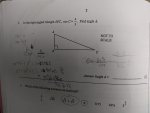I'm really confused! I know trigonometry well enough and I know how you can use the right angle to solve the opposite sides, etc. But this easy 2 mark question is making my mind itch.
Here it is:

Ignore my working. I tried to use cosine rule, etc. too. I don't know how to find out C. By the way, the answers sheet said:
"C = 36.9, must have C stated or markedon the diagramor sinA = 54 or tanA = 34 but must haveA stated2 3 + 6 , π 2 –1 for each"
I still don't understand.
Here it is:
Ignore my working. I tried to use cosine rule, etc. too. I don't know how to find out C. By the way, the answers sheet said:
"C = 36.9, must have C stated or markedon the diagramor sinA = 54 or tanA = 34 but must haveA stated2 3 + 6 , π 2 –1 for each"
I still don't understand.

